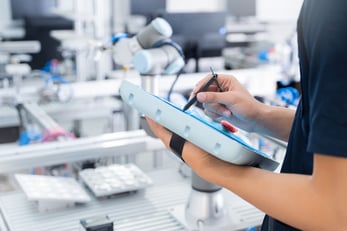 Low-variation and high-volume production characterised by repetitive tasks has been the traditional model in manufacturing. With the introduction of industrial robots, human workers were freed from routine, mundane and high-risk tasks. The decrease in the reliance on human labour also increased productivity, efficiency and production costs.
Low-variation and high-volume production characterised by repetitive tasks has been the traditional model in manufacturing. With the introduction of industrial robots, human workers were freed from routine, mundane and high-risk tasks. The decrease in the reliance on human labour also increased productivity, efficiency and production costs.
However, low-volume production is now more commonplace within UK manufacturing, as customers require more customised products. This means that manufacturing is now done in high-variation or high-mix and low-volume (HMLV) environments.
High-mix and low-volume production offers several distinct market advantages:
- Products being tailored to suit specific customer demand
- Improved responsiveness to market requirements
- Reduction in the inventory requirements for finished goods
But on top of these advantages of HMLV, there are also some manufacturing difficulties it comes with.
High-mix, low-volume production challenges
 Some major challenges with the high-mix, low-volume production scheme are lower productivity and a greater reliance on human workers, which, in turn, increases production costs.
Some major challenges with the high-mix, low-volume production scheme are lower productivity and a greater reliance on human workers, which, in turn, increases production costs.
Remember that in a high-mix, low-volume production environment, the programming and reconfiguration efforts to shift from one product to another can affect production volume. Depending on the products, this type of manufacturing setting might also require several line changeovers to finish the desired output in a given shift.
Additionally, product mixes would entail different levels of changeovers between product batches. With line changeovers lasting anywhere from a few minutes to as many as several weeks (as in the case of heavy equipment or automobile manufacturing), production may sometimes experience bottlenecks or periods of low productivity.
Moreover, high-mix, low-volume production involves the application of stricter quality control measures, as the probability of production errors occurring increases when batch sizes are reduced. The reason for this is that the variability inherent in HMLV production makes it more challenging to achieve or maintain process consistency – something that’s essential in turning out nearly defect-free products.
These are some of the stumbling blocks HMLV manufacturers need to address to provide quality products, meet production goals and reduce operational costs.
Collaborative robots – the solution to growing product mixes
 When it comes to dealing with the challenges posed by high-mix, low-volume production, collaborative robots have become an increasingly attractive option. This is especially true for manufacturers that need flexible solutions for their growing product mix yet don’t have the volume of work or capital required to invest in automation technology.
When it comes to dealing with the challenges posed by high-mix, low-volume production, collaborative robots have become an increasingly attractive option. This is especially true for manufacturers that need flexible solutions for their growing product mix yet don’t have the volume of work or capital required to invest in automation technology.
Collaborative robots or ‘cobots’ require minimal programming to perform tasks and adjust to changes in part sizing and position. By enabling humans to work alongside cobots, you can lessen your reliance on custom fixturing that tends to make HMLV less productive. Some cobots are also mobile, so you can deploy them anywhere the work is on your shop floor.
The utility of collaborative robots can be maximised in the following manufacturing scenarios:
- Manufacturing outfits with a family product mix and employing anywhere between 50 and 500 employees
- Manufacturers looking to have a quick payback period of around six months or so on their capital investments
- Businesses where filling shifts is not feasible but can reassign employees to positions with more added value
- Companies who employ operators performing repetitive or high-risk tasks
Compared to their earlier counterparts and typical industrial robots, collaborative robots today are smaller, lighter and easier to integrate, making them ideal for small and medium-sized manufacturers. They also offer better interoperability within work cells.
Benefits of using collaborative robots for low-volume production
Collaborative robots are designed to share human workspaces or shop floors by performing repetitive, simple, sometimes unsafe or physically taxing tasks. Their flexibility and mobility also help make automation easier for businesses of all sizes.
The advantages offered by collaborative robots are described in greater detail below:
- Ease of programming: Even operators without any programming background or experience can readily set up and operate collaborative robots. Through the use of intuitive, 3D visualisation or arrow keys on a touchscreen tablet, users can manipulate the robot arm to desired waypoints. Hand-guided teaching has also contributed to the ease and speed of configuring collaborative robots. Here, the cobot arm can be moved to the desired position and added to the operational sequence easily, so no complex programming is required.
- Convenient integration: Being lightweight and movable, collaborative robots can be conveniently and quickly integrated into existing infrastructure. There’s no need to make substantial or permanent changes in your shop floor setup. Moreover, unlike technologies that can take months or years to deploy, collaborative robots can be set up and operational in a matter of weeks.
- Output consistency and reliability: Since collaborative robots are programmed to perform specific tasks, expect little to no variation in the output. This kind of automation is crucial to ensuring consistency in your HMLV production so there is no guesswork in your inventory and product quality. Also, improvements in the reliability and accuracy of newer collaborative robots contribute significantly to product quality in high-product variation settings.
- Reduction of operational costs: By reducing a manufacturing facility’s reliance on human labour, operational costs may be kept to a minimum while still meeting quality standards and production targets.
- Safer workspaces: Collaborative robots can take over high-risk, dirty, routine jobs to make manufacturing environments safer, reduce repetitive strain injuries and accidents, and boost morale among human workers.
All of these benefits can make investing in collaborative robots for your HMLV operation one of your wisest, most profitable business decisions.
Collaborative robots – reliable assistants on the shop floor
 Collaborative robots work alongside people, helping to ease the tasks of humans, which is unlike our preconceived notion that robots are replacing people’s jobs.
Collaborative robots work alongside people, helping to ease the tasks of humans, which is unlike our preconceived notion that robots are replacing people’s jobs.
With human-robot collaboration, you can increase productivity by as much as 85 per cent, according to a research by MIT. In this setup, the collaborative robot works a lot like an assistant for a human staff member.
When pure robotics is implemented, you’ll need to do enormous amounts of programming plus install sensors to predict and account for all possible variables. So, instead of using purely robots, having humans present parts to a robot in a welding or subassembly shop floor would be a more cost-effective strategy.
Collaborative robots, meanwhile, are programmed to work with different machines and for various applications. Their interoperability and light weight enable them to be easily redeployed wherever they are needed. Cobots are also designed to run continuously for several years with proper care and maintenance.
Some of the most common types of collaborative robots are:
- Fixed base: These cobots usually have one arm that performs repetitive or routine tasks with parts and tools.
- Wearable: Examples of wearable cobots include exoskeletons where the user directs the movement of the device or machine. Here, the exoskeleton placed on the wearer works as an amplifier that augments or reinforces human action or performance.
- Mobile: These cobots can be placed virtually anywhere on the shop floor and are quite useful in performing pick-and-place tasks and fast line changeovers.
Collaborative robot applications
Collaborative robots can be programmed to perform a wide range of tasks, including ones that are part and parcel of HMLV production, such as:
- Machine tending: This involves the picking and placing of parts or tools.
- Parts and products inspection: Cobots fitted with multiple sensors and high-resolution cameras are equipped to perform hundreds or thousands of inspections without feeling fatigued or distracted.
- Packaging and shipping: Cobots used in this process may be programmed to do anything from shrink wrapping to boxing and loading pallets.
- Welding: Cobots can perform both arc and spot welding or any welding task they are programmed to do.
- Heavy lifting: Lifting tasks are physically taxing for humans – activities that cobots can easily take over and do for as long as they are programmed to.
- Adaptive assembly: Cobots can perform any number of repetitive or assembly line tasks such as driving screws, snapping on components, tightening bolts and applying adhesives.
The incredible versatility of collaborative robots makes them highly appropriate for performing HMLV work, as they can easily take over routine and usually unappealing jobs.
Collaborative robots – game changers of modern manufacturing
Martin Thomas, European Marketing Manager at Radwell International Ltd explains more. “The higher demand for customised products in today’s market is a challenge every manufacturer must face head-on.
By investing in collaborative robots, your manufacturing outfit will be well-equipped to meet changing market demands while meeting your production goals and quality standards, and managing operational costs. Collaborative robots not only offer the maximum return on investment but also function as key enablers in modern manufacturing processes.”









